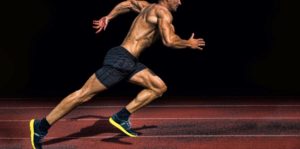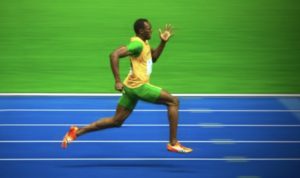https://pubmed.ncbi.nlm.nih.gov/25059334/
Increases in lower-body strength transfer positively to sprint performance: a systematic review with meta-analysis
- PMID: 25059334
- DOI: 10.1007/s40279-014-0227-1
Abstract
Background: Although lower-body strength is correlated with sprint performance, whether increases in lower-body strength transfer positively to sprint performance remain unclear.
Objectives: This meta-analysis determined whether increases in lower-body strength (measured with the free-weight back squat exercise) transfer positively to sprint performance, and identified the effects of various subject characteristics and resistance-training variables on the magnitude of sprint improvement.
Methods: A computerized search was conducted in ADONIS, ERIC, SPORTDiscus, EBSCOhost, Google Scholar, MEDLINE and PubMed databases, and references of original studies and reviews were searched for further relevant studies. The analysis comprised 510 subjects and 85 effect sizes (ESs), nested with 26 experimental and 11 control groups and 15 studies.
Results: There is a transfer between increases in lower-body strength and sprint performance as indicated by a very large significant correlation (r = -0.77; p = 0.0001) between squat strength ES and sprint ES. Additionally, the magnitude of sprint improvement is affected by the level of practice (p = 0.03) and body mass (r = 0.35; p = 0.011) of the subject, the frequency of resistance-training sessions per week (r = 0.50; p = 0.001) and the rest interval between sets of resistance-training exercises (r = -0.47; p ≤ 0.001). Conversely, the magnitude of sprint improvement is not affected by the athlete’s age (p = 0.86) and height (p = 0.08), the resistance-training methods used through the training intervention, (p = 0.06), average load intensity [% of 1 repetition maximum (RM)] used during the resistance-training sessions (p = 0.34), training program duration (p = 0.16), number of exercises per session (p = 0.16), number of sets per exercise (p = 0.06) and number of repetitions per set (p = 0.48).
Conclusions: Increases in lower-body strength transfer positively to sprint performance. The magnitude of sprint improvement is affected by numerous subject characteristics and resistance-training variables, but the large difference in number of ESs available should be taken into consideration. Overall, the reported improvement in sprint performance (sprint ES = -0.87, mean sprint improvement = 3.11 %) resulting from resistance training is of practical relevance for coaches and athletes in sport activities requiring high levels of speed.
CORE Omaha Explains, By Dr. Mark Rathjen PT DPT CSCS.
As the above article states very clearly, there are multiple factors when assessing sprint performance. The Meta analysis which covers over 510 subjects as it relates to one rep squat performance to sprint speed. The correlation is at .87, which for stats is considered high to very high. A 1 to 1 ration correlations perfectly 1-1 or 100% is often un achievable and would show doubling squat strength decreases your time by half. Obviously that is a very un realistic number as it correlates to the real world. This study does suggest such a very high correlation at 87 % is much too high to ignore.
The power of the study also comes from multiple studies measure back squat strength, with over 510 subjects. This related to a very large N, and very good statistical analysis.
Your athletes should be squatting, no doubt about that, and we have seen that in as little as 8 weeks in other studies, performance improves quite significantly without increases in body mass. Why is this relevant? If that is still in question, you are missing the entire point of the meta analysis. Sprint performance translates to athletic performance to almost all sports. Football, soccer, rugby, track and lacrosse would be the most involved because of high speed and large fields to achieve top speed are require. Often an athlete will need 60m to achieve top speed, as often demonstrated by olympic level sprinters.
C.O.R.E. Physical Therapy and Sports Performance PC,
is owned and Operated by Dr. Mark
Rathjen and Dr. Claire Rathjen. CORE is a family owned business that has been established in
2015 and is proud to serve the greater Omaha metro area.
We specialize in the treatment of athletes.
For More information, Please feel free to contact us https://coreomaha.com/contact/
Please feel free to follow us at https://www.facebook.com/COREomaha/
To get started https://coreomaha.com/getting-started/
For more Blog information https://coreomaha.com/blog/
CORE Physical Therapy and Sports Performance PC.
17660 Wright St, suites 9/10
Omaha, NE 68130
402-933-4027
Similar articles
-
Sports Med. 2016 Feb;46(2):231-40. doi: 10.1007/s40279-015-0415-7.PMID: 26508319 Review.
-
J Strength Cond Res. 2020 Jan;34(1):54-64. doi: 10.1519/JSC.0000000000003035.PMID: 30844983 Clinical Trial.
-
Sports Med. 2018 Sep;48(9):2143-2165. doi: 10.1007/s40279-018-0947-8.PMID: 29926369 Review.
-
J Sci Med Sport. 2019 Jul;22(7):838-851. doi: 10.1016/j.jsams.2019.01.006. Epub 2019 Jan 16.PMID: 30683485
-
Sports Med. 2013 May;43(5):367-84. doi: 10.1007/s40279-013-0031-3.PMID: 23529287 Review.
C.O.R.E. Physical Therapy and Sports Performance PC, is owned and Operated by Dr. Mark
Rathjen and Dr. Claire Rathjen. CORE is a family owned business that has been established in
2015 and is proud to serve the greater Omaha metro area.
We specialize in the treatment of athletes.
For More information, Please feel free to contact us https://coreomaha.com/contact/
Please feel free to follow us at https://www.facebook.com/COREomaha/
To get started https://coreomaha.com/getting-started/
For more Blog information https://coreomaha.com/blog/
Frequently asked Questions
Follow us on Google
This is who we are, This is what we do…
CORE Physical Therapy and Sports Performance PC.
17660 Wright St, suites 9/10
Omaha, NE 68130
402-933-4027


